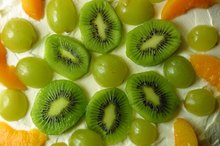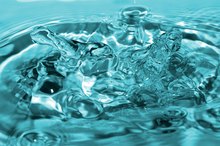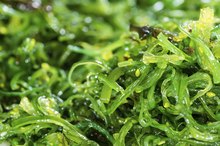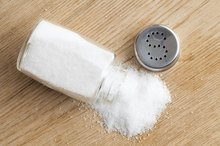How Potassium Reacts With Iodine
Potassium and iodine are two elements, or simple forms of matter. They can react with each other through a specific sort of chemical interaction called an electron transfer, leading to the formation of potassium iodide salt. This reaction yields significant quantities of energy and takes place quickly because it's very chemically favorable.
Significance
The potassium and iodine reaction is a ionization reaction, also called a redox reaction. According to Reginald Garrett and Charles Grisham in their book, "Biochemistry," a redox, or reduction-oxidation, is an electron-transfer reaction 1. Specifically, an atom of potassium transfers an electron to an atom of iodine, producing the positively charged potassium cation and the negatively charged iodide anion. These charged particles, or ions, are subsequently attracted to one another by electrostatic forces, and form the potassium iodide salt.
- The potassium and iodine reaction is a ionization reaction, also called a redox reaction.
- Specifically, an atom of potassium transfers an electron to an atom of iodine, producing the positively charged potassium cation and the negatively charged iodide anion.
Features
Dehydration & Potassium Levels
Learn More
The reaction of potassium with iodine is the result of each neutral atom having an unfilled outer shell of electrons, or valence shell. In his book, “Chemistry: The Molecular Nature of Matter and Change," Martin Silberberg explains that unfilled valence shells are unstable, while either empty or filled valence shells are stable 2. By reacting with iodine, potassium loses its one valence electron, emptying its valence shell. By reacting with potassium, iodine gains a valence electron, filling its valence shell.
- The reaction of potassium with iodine is the result of each neutral atom having an unfilled outer shell of electrons, or valence shell.
- By reacting with iodine, potassium loses its one valence electron, emptying its valence shell.
Considerations
Electron transfer reactions result in formations of ions because the charges in an atom become unbalanced. Unreacted atoms are neutral--they have the same number of protons as neutrons. Notes Silberberg, potassium has 19 positvely charged protons and 19 negatively charged electrons as an unreacted atom. When it gives an electron to iodine, it has 19 protons and 18 electrons, which gives it a positive charge. Similarly, through gaining an electron, iodine becomes negatively charged.
- Electron transfer reactions result in formations of ions because the charges in an atom become unbalanced.
- Unreacted atoms are neutral--they have the same number of protons as neutrons.
Effects
Fun Facts About Potassium
Learn More
As a result of the reaction of potassium and iodine, a water soluble salt forms. Neither elemental potassium nor elemental iodine can dissolve in water because water is better at dissolving compounds with charges than neutral elements. The potassium iodide salt, because it's made up of charged particles, dissolves readily in water. Solutions of potassium iodide in water also conduct electricity, notes Silberberg. They're called electrolyte solutions. The reaction of potassium with iodine changes the physical and chemical properties of both elements.
- As a result of the reaction of potassium and iodine, a water soluble salt forms.
- The potassium iodide salt, because it's made up of charged particles, dissolves readily in water.
Misconceptions
Because many chemical reactions result in the formation of a chemical bond, it's common to assume that when potassium reacts with iodine, the resulting compound--potassium iodide--is held together by a chemical bond. In fact, this is not so, notes Silberberg. The only force holding the compound together is electrostatic, meaning the attractive force between unlike charged particles. As such, when dissolved in water, potassium cations can separate from iodide anions, producing free-floating ions in solution.
- Because many chemical reactions result in the formation of a chemical bond, it's common to assume that when potassium reacts with iodine, the resulting compound--potassium iodide--is held together by a chemical bond.
- As such, when dissolved in water, potassium cations can separate from iodide anions, producing free-floating ions in solution.
Related Articles
References
- “Biochemistry”; Reginald Garrett, Ph.D. and Charles Grisham, Ph.D.; 2007
- “Chemistry: The Molecular Nature of Matter and Change”; Martin Silberberg, Ph.D.; 2008
Writer Bio
Kirstin Hendrickson is a writer, teacher, coach, athlete and author of the textbook "Chemistry In The World." She's been teaching and writing about health, wellness and nutrition for more than 10 years. She has a Bachelor of Science in zoology, a Bachelor of Science in psychology, a Master of Science in chemistry and a doctoral degree in bioorganic chemistry.








